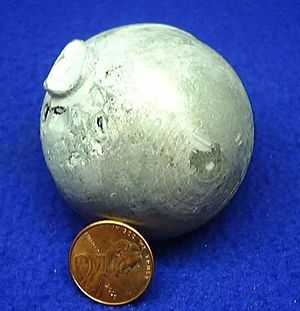Cadmium
Template:Elementbox header Template:Elementbox series Template:Elementbox groupperiodblock Template:Elementbox appearance img Template:Elementbox atomicmass gpm Template:Elementbox econfig Template:Elementbox epershell Template:Elementbox section physicalprop Template:Elementbox phase Template:Elementbox density gpcm3nrt Template:Elementbox densityliq gpcm3mp Template:Elementbox meltingpoint Template:Elementbox boilingpoint Template:Elementbox heatfusion kjpmol Template:Elementbox heatvaporiz kjpmol Template:Elementbox heatcapacity jpmolkat25 Template:Elementbox vaporpressure katpa Template:Elementbox section atomicprop Template:Elementbox crystalstruct Template:Elementbox oxistates Template:Elementbox electroneg pauling Template:Elementbox ionizationenergies3 Template:Elementbox atomicradius pm Template:Elementbox atomicradiuscalc pm Template:Elementbox covalentradius pm Template:Elementbox vanderwaalsrad pm Template:Elementbox section miscellaneous Template:Elementbox magnetic Template:Elementbox eresist ohmm Template:Elementbox thermalcond wpmkat300k Template:Elementbox thermalexpansion umpmkat25 Template:Elementbox speedofsound rodmpsat20 Template:Elementbox youngsmodulus gpa Template:Elementbox shearmodulus gpa Template:Elementbox bulkmodulus gpa Template:Elementbox poissonratio Template:Elementbox mohshardness Template:Elementbox brinellhardness mpa Template:Elementbox cas number Template:Elementbox isotopes begin Template:Elementbox isotopes decay Template:Elementbox isotopes decay Template:Elementbox isotopes decay Template:Elementbox isotopes stable Template:Elementbox isotopes stable Template:Elementbox isotopes stable Template:Elementbox isotopes decay Template:Elementbox isotopes decay2 Template:Elementbox isotopes decay Template:Elementbox isotopes decay Template:Elementbox isotopes end Template:Elementbox footer
Cadmium is a chemical element in the periodic table that has the symbol Cd and atomic number 48. A relatively rare, soft, bluish-white, toxic transition metal, cadmium occurs with zinc ores and is used largely in batteries.
Production
Cadmium is a common impurity in zinc, and it is most often isolated during the production of zinc. Zinc sulfide ores are roasted in the presence of oxygen converting the zinc sulfide to the oxide. Zinc metal is produced either by smelting the oxide with carbon or by electrolysis in sulfuric acid. Cadmium is isolated from the zinc metal by vacuum distillation if the zinc is smelted, or cadmium sulfate is precipitated out of the electrolysis solution.[1]
Notable characteristics
Cadmium is a soft, malleable, ductile, bluish-white bivalent metal which can be easily cut with a knife. It is similar in many respects to zinc but reacts to form more complex compounds.
The most common oxidation state of cadmium is +2, though rare examples of +1 can be found.
Applications
About three-fourths of cadmium is used in batteries (especially Ni-Cd batteries) and most of the remaining one-fourth is used mainly for pigments, coatings and plating, and as stabilizers for plastics. Other uses;
- Used in some of the lowest melting alloys.
- Due to a low coefficient of friction and very good fatigue resistance, it is used in bearing alloys.
- 6% of cadmium finds use in electroplating.
- Many kinds of solder contain this metal.
- As a barrier to control nuclear fission.
- Compounds containing cadmium are used in black and white television phosphors and also in the blue and green phosphors for color television picture tubes.
- Cadmium forms various salts, with cadmium sulfide being the most common. This sulfide is used as a yellow pigment. Cadmium selenide can be used as red pigment, commonly called cadmium red. To painters who work with the pigment, Cadmium yellows, oranges and reds are the most potent colours to use. In fact,during production these colours are significantly toned down before they are ground with oils and binders, or blended into watercolours, gouaches, casesin, acrylics and other paint and pigment formulations. These pigments are toxic and it is recommended to use a barrier cream on your hands to prevent absorbtion through the skin when working with them. There is no such thing as cadmium blue, green or violet.
- Used in some semiconductors such as cadmium sulfide, cadmium selenide, and cadmium telluride, which can be used for light detection or solar cells. HgCdTe is sensitive to infrared.
- Some cadmium compounds are employed in PVC as stabilizers.
- Used in the first neutrino detector.
- Used to block voltage-dependent calcium channels from fluxing calcium ions in molecular biology.
See also Cadmium compounds.
History
Cadmium (Latin cadmia, Greek kadmeia meaning "calamine") was discovered in Germany in 1817 by Friedrich Strohmeyer. Strohmeyer found the new element within an impurity in zinc carbonate (calamine) and for 100 years Germany remained the only important producer of the metal. The metal was named after the Latin word for calamine since the metal was found in this zinc compound. Strohmeyer noted that some impure samples of calamine changed color when heated but pure calamine did not.
Even though cadmium and its compounds are highly toxic, the British Pharmaceutical Codex from 1907 states that cadmium iodide was used as a medicine to treat "enlarged joints, scrofulous glands, and chilblains".
In 1927, the International Conference on Weights and Measures redefined the meter in terms of a red cadmium spectral line (1m = 1,553,164.13 wavelengths). This definition has since been changed (see krypton).
Occurrence
Cadmium-containing ores are rare and when found they occur in small quantities. Greenockite (CdS), the only cadmium mineral of importance, is nearly always associated with sphalerite (ZnS). Consequently, cadmium is produced mainly as a byproduct from mining, smelting, and refining sulfide ores of zinc, and to a lesser degree, lead and copper. Small amounts of cadmium, about 10% of consumption, are produced from secondary sources, mainly from dust generated by recycling iron and steel scrap. Production in the United States began in 1907 but it was not until after World War I that cadmium came into wide use.
- See also Category:Cadmium minerals.
Isotopes

Naturally occurring cadmium is composed of 8 isotopes. For two of them, natural radioactivity was observed, and other three are predicted to be radioactive but their decays were never observed, due to extremely long half-life times. The two natural radioactive isotopes are 113Cd (beta decay, half-life is 7.7 X 1015 years) and 116Cd (two-neutrino double beta decay, half-life is 2.9 X 1019 years). Other three ones are 106Cd, 108Cd (double electron capture), and 114Cd (double beta decay); only lower limits on their half-life times have been set. At least three isotopes - 110Cd, 111Cd, and 112Cd - are absolutely stable. Among the isotopes absent in the natural cadmium, the most long-lived are 109Cd with a half-life of 462.6 days, and 115Cd with a half-life of 53.46 hours. All of the remaining radioactive isotopes have half-lifes that are less than 2.5 hours and the majority of these have half-lifes that are less than 5 minutes. This element also has 8 known meta states with the most stable being 113mCd (t½ 14.1 years), 115mCd (t½ 44.6 days) and 117mCd (t½ 3.36 hours).
The known isotopes of cadmium range in atomic weight from 96.935 u (97Cd) to 129.934 amu (138Cd). The primary decay mode before the second most abundant stable isotope, 112Cd, is electron capture and the primary modes after are beta emission and electron capture. The primary decay product before 112Cd is element 47 (silver) and the primary product after is element 49 (indium).
Precautions
Cadmium has no constructive purpose in the human body. This element and solutions of its compounds are extremely toxic even in low concentrations, and will bioaccumulate in organisms and ecosystems. One possible reason for its toxicity is that it interferes with the action of zinc-containing enzymes. Zinc is an important element in biological systems, but cadmium, although similar to zinc chemically in many ways, apparently does not substitute or "stand in" for it well at all. Cadmium may also interfere with biological processes containing magnesium and calcium in a similar fashion. Pathways of human contact include soil contamination from industrial releases or landfill and associated leachate processes.
Inhaling cadmium laden dust quickly leads to respiratory tract and kidney problems which can be fatal (often from renal failure). Ingestion of any significant amount of cadmium causes immediate poisoning and damage to the liver and the kidneys.
Compounds containing cadmium are also carcinogenic [2], and can induce many types of cancer [3].
Cadmium poisoning is the cause of the itai-itai disease, which literally means "pain pain" in Japanese. In addition to kidney damage, patients suffered from osteoporosis and osteomalacia.
While working with cadmium it is important to do so under a fume hood to protect against dangerous fumes. Silver solder, for example, which contains cadmium, should be handled with care. Serious toxicity problems have resulted from long-term exposure to cadmium plating baths.
Template:Wiktionarypar Template:Commons
References
External links
- IARC Monograph "Cadmium and Cadmium Compounds"
- National Pollutant Inventory - Cadmium and compounds
- WebElements.com – Cadmium
- Los Alamos National Laboratory – Cadmium
ar:كادميوم
ca:Cadmi
cs:Kadmium
co:Cadmiu
da:Cadmium
de:Cadmium
et:Kaadmium
el:Κάδμιο
es:Cadmio
eo:Kadmio
fr:Cadmium
ko:카드뮴
hy:Կադմիում
hr:Kadmij
io:Kadmio
id:Kadmium
is:Kadmín
it:Cadmio
he:קדמיום
ku:Kadmiyûm
la:Cadmium
lv:Kadmijs
lb:Cadmium
lt:Kadmis
hu:Kadmium
nl:Cadmium
ja:カドミウム
no:Kadmium
nn:Kadmium
oc:Cadmi
ug:كادمىي
pl:Kadm
pt:Cádmio
ru:Кадмий
sq:Kadmiumi
simple:Cadmium
sl:Kadmij
sr:Кадмијум
sh:Kadmijum
fi:Kadmium
sv:Kadmium
th:แคดเมียม
vi:Cadmi
tr:Kadmiyum
uk:Кадмій
uz:Kadmiy
zh:镉

